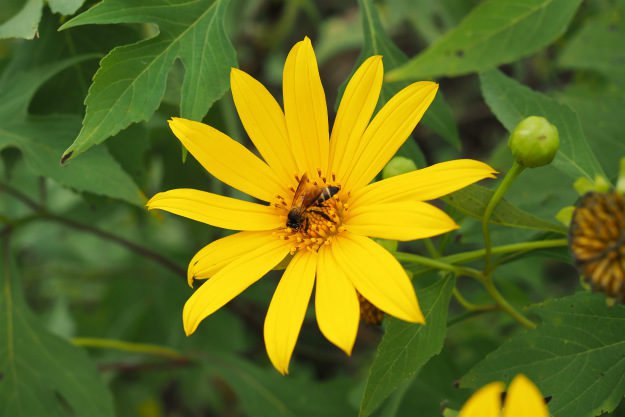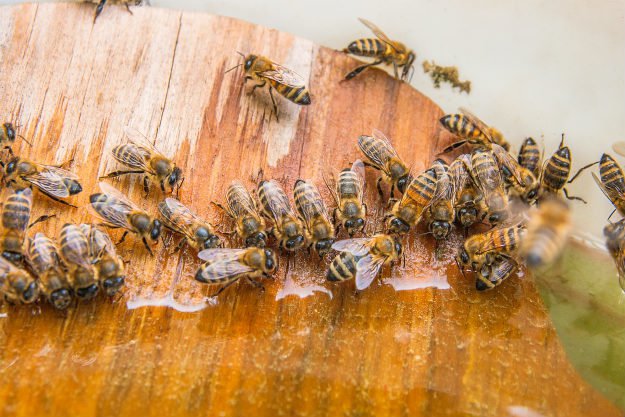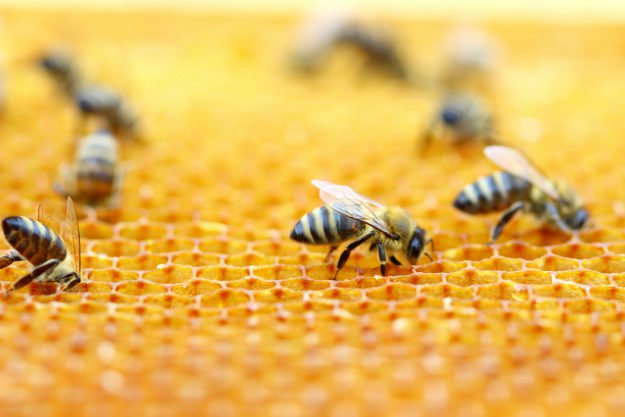Have you ever considered turning your backyard into a bee haven? There are so many fantastic benefits of making your outdoor living space more bee-friendly. Check out these ideas to start your own backyard beekeeping!
Backyard Beekeeping | How to Turn Your Backyard into a Bee Haven
On October 31st, seven native Hawaiian bees were added to the endangered species list. After years of warnings from various environmental and animal groups, the alarming decline of the bee population is finally being acknowledged in a real, and terrifying way.
According to the U.S. Department of Agriculture, bees pollinate 80% of our flowering crops — which comprises a third of everything we eat. They’re responsible for the continued survival of many of our most precious native plants. Yet, despite being an absolutely vital component of our ecosystem, we still engage in a lot of the behaviors that have led to their diminishing population.
Unfortunately — as is so often the case — it’ll take time before the government catches up with the rest of us. It will be a while before they take action to protect all bees that make their home in the US. Until then, you can play a small (but very important) role in saving the bees by transforming your yard into a safe harbor. Here’s how:
Backyard Beekeeping 101

Offer Plenty of Food
Luckily for us, bee food primarily comes in the form of flowers — allowing you to help the bees and boost curb appeal at the same time. Here are some tips on planting the kind of flowers our sweet pollinating friends love best.
- Different bees are active at various points of the year, making it important to plant a wide array of flowers that bloom from early spring through late fall.
- Native wildflowers (either annual or perennial) are the best source pollen and nectar for bees.
- Bees are most attracted to blue, purple, and yellow flowers with flat or shallow blossoms where pollen and nectar are easily accessible.
- Since bees frequently return to clearly visible flower beds, plant large groups of like flowers, rather than a variety of flowers spread in a wide area.
Provide a Water Supply
All creatures need water, including bees. While native bees simply drink the water, honeybees use it to cool the hive and dilute honey. One of the best ways to attract bees to your yard is to give them a safe and accessible water supply. Here are a few ways to do so:
- Fill a bucket or pail with water, and float a generous amount of wine corks on the surface to create landing pad so bees can drink their fill without drowning.
- Fill a shallow bird bath with water and flat stones for perching.
- Put a frisbee full of clean rocks underneath an outside faucet. Turn the faucet on so it drips once per minute.
- Buy a few bags of decorative glass pebbles and put them in a large, shallow container. Fill it with fresh water daily and place it near your garden.
Bees almost never store water — they drink it or bring to the hive as needed. It’s vital you continuously provide them with fresh water, refreshing buckets and birdbaths every day, or every other day.
Give Them a Cozy Home
Most bees don’t live in hives and colonies — they’re solitary wanderers who make their own homes. You can help them out by creating a safe nesting habitat in your yard.
Wood and cavity nesting bees lay their eggs in reeds, old beetle tunnels, and similar locations. They’re opportunistic and will happily use man-made nests as well. You can purchase bee houses from your local garden supply store. Another option is to create your own at home by drilling holes into wooden blocks, logs, or by binding together hollow reeds. Place your nests where they are sheltered from the worst of the weather, and where the holes get morning sun.

Ground nesting bees need bare patches of gently compacted earth in which to excavate brood chambers. Choose a site that is well drained and receives a decent amount of sun. Level or slightly slope sites will attract different species of native bees, so it’s a good idea to create a few different spots to maximize nesting potential.
Bumblebees live in small colonies, and as such, their nesting boxes will need to be a bit larger. You can view a tutorial on how to build a bumblebee nesting box here. Place your nest in partial or full shade, on or just under the ground, where there’s no risk of flooding.
General Rule of Thumb
Finally — and most importantly — it’s absolutely imperative that you do not use pesticides in your yard. While they will certainly take care of any nasty pests you don’t want around, they will also kill the bees. Instead, take advantage of beneficial insects such as ladybugs, hoverflies, lacewings, and parasitic wasps. You can plant an insectary to attract them, or buy them from local garden supply stores for natural and safe backyard beekeeping.
While creating a habitat in our yards is just a small part in ensuring the safety of the bees and their continued survival, it’s still incredibly important. Even small steps can make a big difference!
Discover everything a beginner beekeeper needs to start producing honey!
Did you like our post on Backyard Beekeeping? Tell us what you think in the comments section below!
Follow us on instagram, twitter, pinterest, and facebook!
Want more about the buzz on bees? Check out these other fantastic bee articles here with this post: What’s The Buzz On Bees? | Beekeeping Info For Savvy Homesteaders


[…] Backyard Beekeeping | How to Turn Your Backyard into a Bee Haven […]